If, as we stated in our BaselWorld 2009 wrap-up report, the mechanical extravagances that have been so pronounced over the last few years were no longer the priority, but rather have ceded their place to a return to certain standards and more realism, we must not believe that all research has stopped. Far from it. Exceptional watches still made the headlines and a number of initiatives—often collective—have shown that the labora-tories of watchmaking are still alive and well.
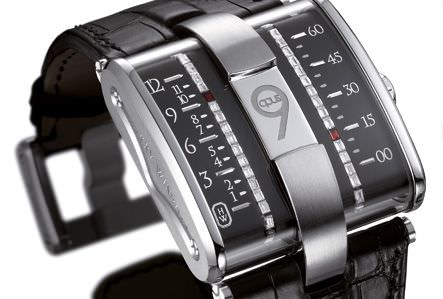
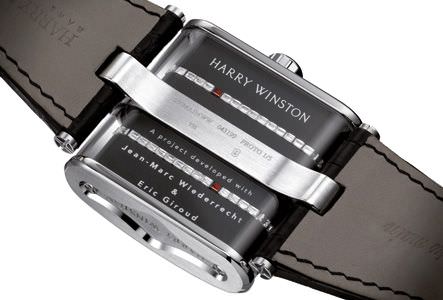
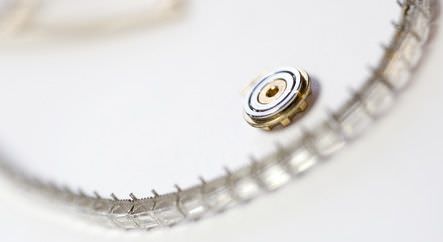
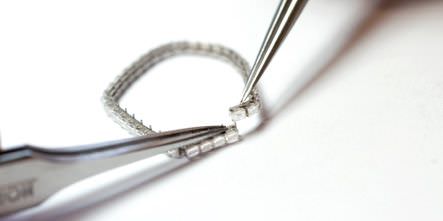
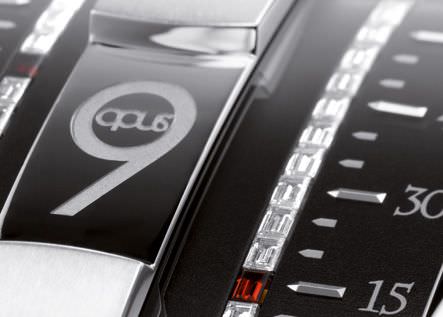
OPUS 9 by Harry Winston
One of the most remarkable pieces that has been presented at BaselWorld is the Opus 9 by Harry Winston, the fruit of the combined talents of Jean-Marc Wiederrecht, for his watchmaking skills, and Eric Giroud for his design.
The fusion at work here between a totally innovative technique—the linear display of the hours and minutes by two small parallel chains—and a minimalist design, which puts diamonds directly in the service of timekeeping for the first time, makes this timepiece the most Winston of the Opus series. Because of its simplicity in reading the time—we get it at first glance—this Opus 9 is also emblematic of a watchmaking that, even if it is considered avant-garde, avoids the trap of making an exploit merely for the sake of achieving an exploit.
Conceived in June 2008, the project “ran itself”, according to Jean-Marc Wiederrecht. Modest as always, this talented watchmaker minimizes the difficulties the team encountered (as a reminder, he was named Best Constructor of the Year in the Geneva Grand Prix of timekeeping). The use of small chains is not a first, but behind the apparent sim-plicity of this type of display is a sophisticated savoir-faire that this expert in retrograde indications has wonderfully mastered. After all, isn’t it often more complicated to make something simple than to make something simple complicated! It is also more difficult to find the most elegant solution rather than simply increasing the number of component parts.
The basis of this piece is a FrÉdÉric Piguet automatic movement. Its rotational indication of the hours and minutes is transformed into linear motion by a rack and pinion mech-anism that drives the continuous movement of two small chains sliding on six ball bearings positioned on the same plane. These chains thus rotate around the movement without stopping. It is the ultimate retrograde, you might say, that will continue forever.
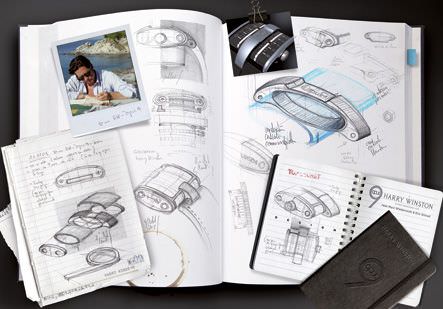

Jean-Marc Wiederrecht & Eric Giroud
The small chains are designed in a way to minimize rubbing and are made of 36 brass links set with carefully calibrated diamonds and two garnets that give the hour or the minutes (one garnet appears on the dial at the moment the other disappears around the back, where it remains visible under a sapphire crystal). This sophisticated technical solution was created in collaboration with the designer Eric Giroud. The movement is lat-erally encapsulated in a case with no back, strictly speaking, but in a white gold framework with a large central bridge that circles an extraordinary single-block sapphire crystal. In this way, the chain of diamonds can be seen along its entire course over 360 degrees.
This central blade is not only a strong design element of the watch but is its ‘vertebral column’, supporting the mobile components and protecting it against shock. For Eric Giroud, the idea of the central blade was the starting point of his composition. His inspiration? He was working on his design at the beach when he saw some jellyfish floating between two waters. The idea then came to him to have diamonds ‘float’ between two sapphire crystals. The Opus 9 thus became both a watch and a poetic object, which fit perfectly into the image of Harry Winston, an exemplary result of collaboration between a watchmaker and a designer.
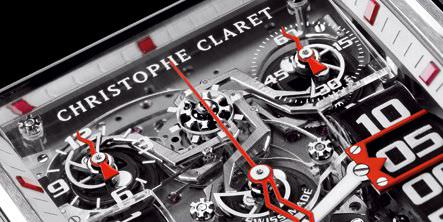
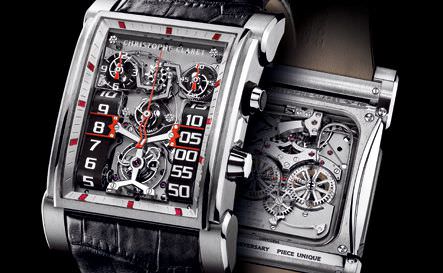
DUALTOW by Christophe Claret
The DualTow, from the Christophe Claret manufacture
A whole different approach was followed by Christophe Claret, who for the 20th anniversary of his manufacture, presents what he himself calls an exceptional object. The DualTow is a global single-button chronograph with a chime and a tourbillon. It is a “machine to measure time” that is representative of the savoir-faire of the Christophe Claret manufacture where the near totality of the required operations for its production were carried out.
We already knew Christophe Claret to be a great expert in watches with chimes. And he again shows this to be the case with an interesting first where he linked the gong to the chronograph. Each time that the chronograph is activated, a gong chimes, warning of the start or stop of the chronograph function. It is in the operation of the single-pushbutton chronograph that Claret has made the greatest innovation, protected by a patent. It functions in a quite original manner thanks to three identical planetary differential wheels. The entry wheel of these planetary wheels is directly linked to the movement and is continuously driven. Pivoting on the same axis, a satellite carrier can engage the exiting wheel in the upper part of the satellite carrier via two superimposed satellites. Attached to this exit wheel is a cam on which a hand is mounted.
When the chronograph is de-activated, the continuously rotating entry wheel drives the satellite carrier that turns in a void. In the start position, the satellite carrier is blocked and the movement of the entry wheel is transmitted directly to the hand. At the centre of this device, made up of three planetary differential wheels (hours, minutes and seconds), a column wheel drives the operations via six levers and hammers in the form of ‘legs’ that give the ensemble the gracious allure of a mechanical ballet.
One of the advantages of this complex device is to minimize the amplitude variation of the balance because, since the entry wheels continuously rotate, the torque required by the chronograph function does not vary, regardless of its position, start, stop, or reset. In this manner, the precision should be greater.
These elements are attached to a part fixed to the plate whose form evokes the barrel of a revolver. Claret thus calls it “barillot”. Everything is highly visible. The hour counters (at 11 o’clock) and the minute counter (at 1 o’clock) on the sapphire crystal are placed on each side of the column wheel mechanism, while the seconds hand is at the centre. Below, the tourbillon is framed by two large rubber belts driven by cylinders. As they move, they indicate the hours and minutes thanks to frames fixed on the tourbillon bridge. Each DualTow is unique thanks to a palette of colours available on the watch’s website (www.dualtow.ch) that lets each watch be personalized in terms of colour. (We will come back to this unusual watch and the Claret manufacture in detail in the Special Mechanicals section of our next issue, no. 4/2009).
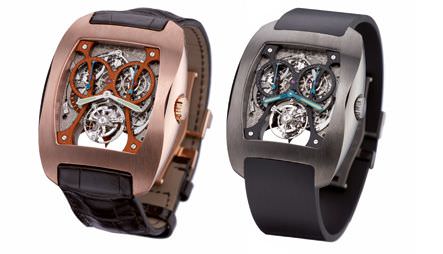
CHRONO TOURBILLON PULSION by ConfrÉrie HorlogÈre
ConfrÉrie HorlogÈre
Exhibiting outside of BaselWorld, at the HÔtel des Trois Rois, Mathias Buttet, owner of BNB and initiator of the ConfrÉrie HorlogÈre (CH) savoured the moment. One of the pieces that he had worked on was a hit at BaselWorld: the Quantum Gravity by Concord, which we have already spoken at length about in our last issue (No. 2/2009). But, in his suite at the hotel, Mathias Buttet presented a vast program of other developments.
Initially, the CH was supposed to only be a line of Complications composed of original watches signed each by one of the ConfrÈres (members/colleagues). (On this subject, see article in issue no 1/2009.) Since then, however, the program has grown by leaps and bounds. A second line, Classiques, and a third called Masters have come onboard. The Classics line responds to demands by retailers for a more ‘commercial’ offer to complete the Complications collection, which is itself made up of extremely personal—and thus less ‘commercial’—watches.
Pieces in the Complications line are collective endeavours, designed, and realized by the ConfrÈres as a group. The case, in the form of a sphere segment, is identical for all models. The basic movement is made of aluminium-lithium, treatable in 200 possible colours, mounted on a plate decorated in a very particu-lar honeycomb pattern.
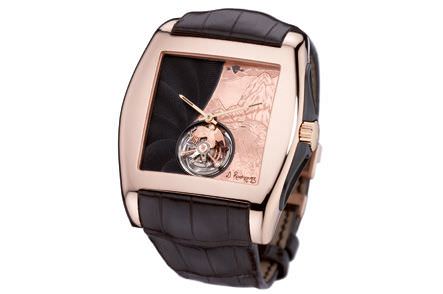
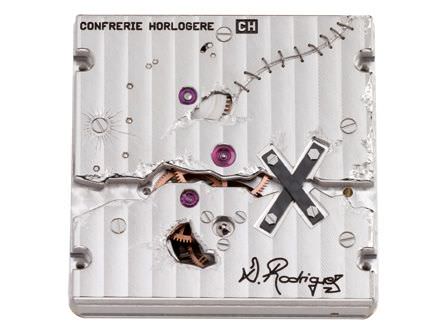
DAVID RODRIGUEZ RESILIENCE by ConfrÉrie HorlogÈre
The first of the new Classics is a Tourbillon Chronograph called ‘Pulsion’, a column-wheel chronograph that is linked directly to a suspended flying tourbillon carriage that turns without ball bearings. In the same collection, the CH announces the creation of a Big, equipped with a two-barrel movement giving 22 hours of power reserve. The elements and indications will be placed in an unusual fashion (large date at 6 o’clock, tourbillon at 9 o’clock, hour and minute at 3 o’clock, power reserve indicator at 12 o’clock) as well as a basic movement equipped with three barrels (BNB has recently acquired 30 per cent of GÉnÉrale Ressorts, (which partially explains this), thus procuring it a theoretical working reserve of 14 days.
The Masters line is a testament to a reality that has become increasingly obvious: the progressive influence of engineers in the world of timekeeping. It will therefore be a very technical piece, made up of (fewer) parts in keeping with a concept developed by the CH technicians, engineers, and specialists. It will be a veritable laboratory where the first anticipated watch will feature a ‘speed selector’ allowing it to be sped up or slowed down at will (in April, only the first prototype was available but the timekeeper should be ready for the ‘Only Watch’ show in Monaco, September 23 and 24). In the ‘standard’ mode, the hands, slowed or accelerated in order to catch up to the ‘exact’ time. With this certainly highly technical creation, Mathias Buttet (who himself does not even wear a watch), pokes his tongue out at the standardization of time. “Doesn’t boring time pass much more slowly than hours of passion?” he asks sardonically. Twenty-four pieces of this extraordinary object, including a dual-time zone model, are planned.
Finally, the initial line, Complications, announced this past autumn, welcomes the arrival of a first and rather amazing piece, the Tourbillon RÉsilience by David Rodriguez. When seeing this piece, you are at first struck by the strangeness of the dial, which seems cut in two. One side is a mysterious black guilloche decoration, while the other is an engraving representing the famous Inca archaeol-ogical site of Machu Picchu that frames the tourbillon, whose bridge is shaped like a condor from the Andes. The back, however, reveals the tragic and magnificent story of David Rodriguez. The back of the movement seems to be cut into two pieces by a flaw held together by a carbon fibre X. Elsewhere, through scars and wounds, the gears can be seen. The piece’s entrails are sewn together and convey the destiny of this Peruvian child abandoned at birth, mistreated, and then struck with polio. Constrained to walk with crutches, he was adopted and moved to Switzerland where he found his way. Today, he himself is a father and now is part of the talented CH group.
The RÉsilience Tourbillion is emblematic of the personal approach that each member of the ConfrÉrie HorlogÈre brings to their creations. We can thus soon admire another and totally different piece, the ImmenSEAty by Gabriel Salgado de Arce, a veritable ‘nano-sculpture’ for the wrist that indicates the time on Earth, Neptune, Uranus, and Saturn. It is a pure masterpiece of engraving, immensely poetic, and marvellously creative (we can testify to this, having admired it under a microscope). This in itself is also one of the ‘laboratories’ of timekeeping.
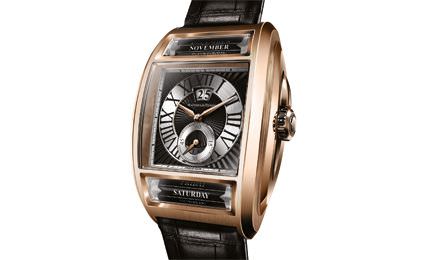
chapter two by MaÎtres du Temps
At six hands
A whole other ‘laboratory’ but one that is also collective in its own way is the MaÎtres du Temps, which presented their Chapter Two. For this second chapter in an adventure that begun two years ago, Steven Holtzman brought together Peter Speake-Marin, Roger Dubuis and Daniel Roth. What a pleasure to see Roger Dubuis and Daniel Roth again, who have lost nothing of their legendary gentleness. These two men have more in common than their great love of watchmaking—they both have ‘lost’ their own name since neither Roger Dubuis nor Daniel Roth have anything more to do with the brands that bear their names.
As both men say, at this stage of experience, “what is important is the transmission”. Evoking all the masters that have taught him, Roger Dubuis affirms that it is now his turn to “know how to say thank you”. And how do you say “thank you?” “By passing the torch”.
With Peter Speake-Marin, they have designed a calendar watch (large date, day and month) whose main feature is that the day and month are indicated on two different rolling barrels made of ultra-lightweight anodized aluminium, arranged longitudinally under their own sapphire crystal at 6 o’clock for the day and 12 o’clock for the month.
This particular arrangement is extremely readable—no other complete calendar comes close—and provides a large space for the central dial where the hours, minutes, small seconds at 6 o’clock and large date at 12 o’clock are classically displayed. These three calendar indications jump instantaneously. While the date corrector is located at 2 o’clock, the day and month correctors are ideally accessible on the back of the watch where, under a sapphire crystal, we can admire the very lovely automatic movement, the Calibre SHC01 (382 com-ponents, 50 hours of working reserve, 28,800 vib/h).
Daniel Roth paid particular attention to the finishing of the piece, one of his specialties. Truly remarkable finishings they are too, from the CÔtes de GenÈve pattern decorating the movement, to the circular-graining, bevelled edges, polished screw heads and guillochÉ dial and red gold case. The work is simply irreproachable.
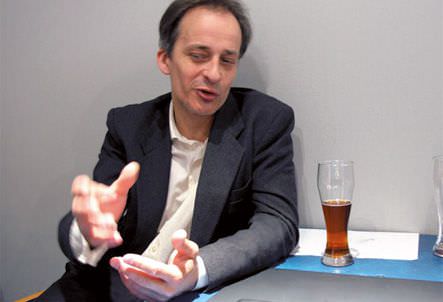
Vianney Halter and a delicious new beer!
Collective spaces
Another collective endeavour, although quite different, is the Watch Factory. In this case, it is not about making watches together but rather about sharing space together at BaselWorld. Initiated by the journalist GrÉgory Pons, this space unites people as different as Alain Silberstein, MB&F, Cabestan, Peter Speake-Marin, Fabrication des Montres Normandes, Rudis Sylva, Urwerk, Steinway & Sons, Beat Haldimann and the Artisans Horlogers. All have small booths with a table, separated by simple plain partitions. What is important is not so much the decor but the warm, friendly and convivial ambiance, to the point that the Watch Factory has become one of the must-sees of BaselWorld.
Europa Star will return with more information in the following issues on some of the brands at the Watch Factory, notably those that we have not covered in detail. Among them will be: Rudis Sylva and his Harmonious Oscillator, a system in which two balances are linked to each other by a single escapement; and Karten FrÄssdorf’s Fabrication de Montres Normandes that revives the great classicism with exceptional movements equipped with a large balance (we also owe him the very lovely independent seconds hand Sauterelle by Chronoswiss); and Steinway & Sons with its ‘second metronome’ model.
Another lively ‘collective’ space was the stand that Vianney Halter shared with his friends, among them the Finnish Kari Voutilainen and Stepan Sarpaneva, Urban JÜrgensen, the indispensable Mariez brothers, John C. Ermel, and Cyclos, etc. We will come back soon to some of the latest creations from these watchmakers but we could not resist the pleasure of citing a few extracts from an open letter than Vianney Halter sent out before BaselWorld.
“It is again time for BaselWorld and with it comes the eternal question: ‘What’s new this year? Will you reveal some new models?’ (…) My response is frank and direct: ‘There will be no new models this year at Vianney Halter.’ Why is it necessary to always present a new Vianney Halter each year? (…) To present a very realistic image in three dimensions is not too difficult while developing a working prototype is something else entirely. And to transpose this operational prototype into a production model that can be fabricated, even in a small series, is a considerable job. To launch a new watch at each BaselWorld is an arms race that we independent watchmakers don’t have the funds for. (…)
In addition, BaselWorld is not necessarily the best place to present a new model because it can be drowned in the flood of new items at the show. I feel that for the last few years, only one or two ‘innovations’ have truly marked the minds of people, while the rest was rapidly forgotten, or worse, outmoded. (…)
When we present a new watch, our goal is not to have a ’talking piece’ or in other words a timekeeper intended only to garner press coverage or buzz on the Internet. Each of our watches is made to be delivered to a knowledgeable and demanding client. (…) When we present a new piece (and we will continue to present new ones in the future), we want to do so from the point of view of creating something strong and consistent in one aspect of timekeeping. We therefore devote the time, energy, and resources necessary to accomplish this.
These are the reasons why the only new thing that you can see and appreciate at the Vianney Halter stand will be the new beer created by my friend and fellow citizen of Sainte-Croix, Raphael Mettler. And, believe me, it is worth the detour…”
Source: Europa Star June-July 2009 Magazine Issue




